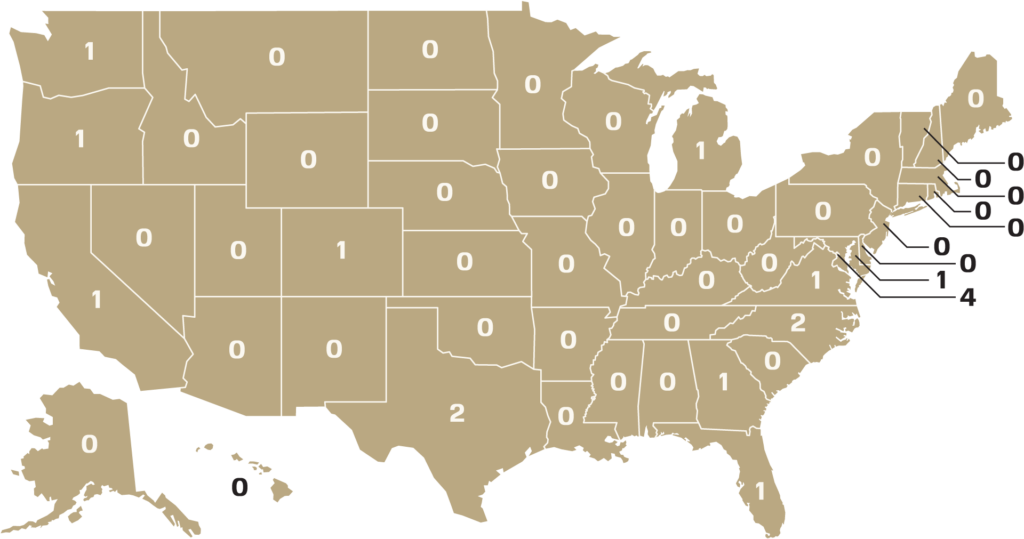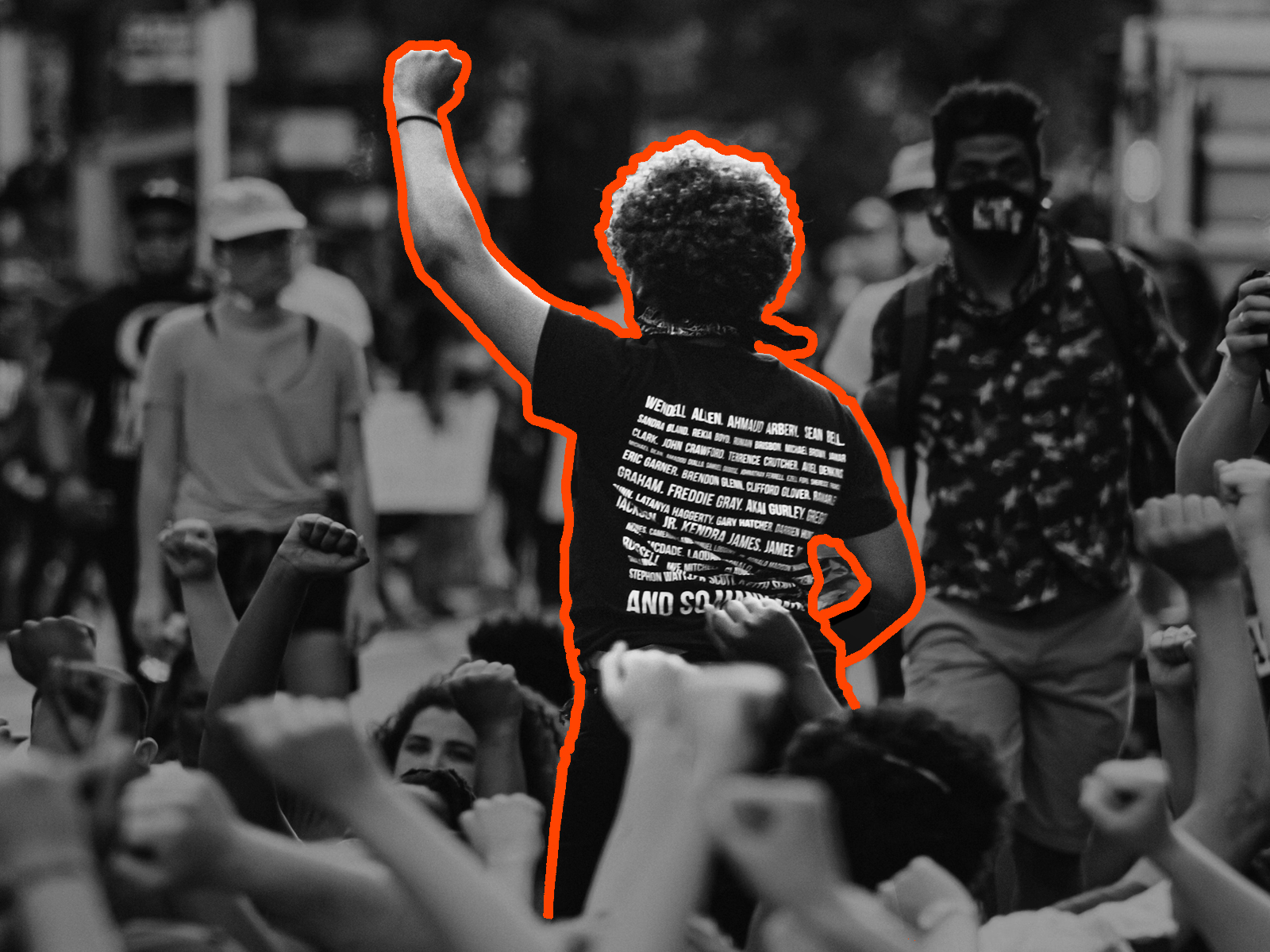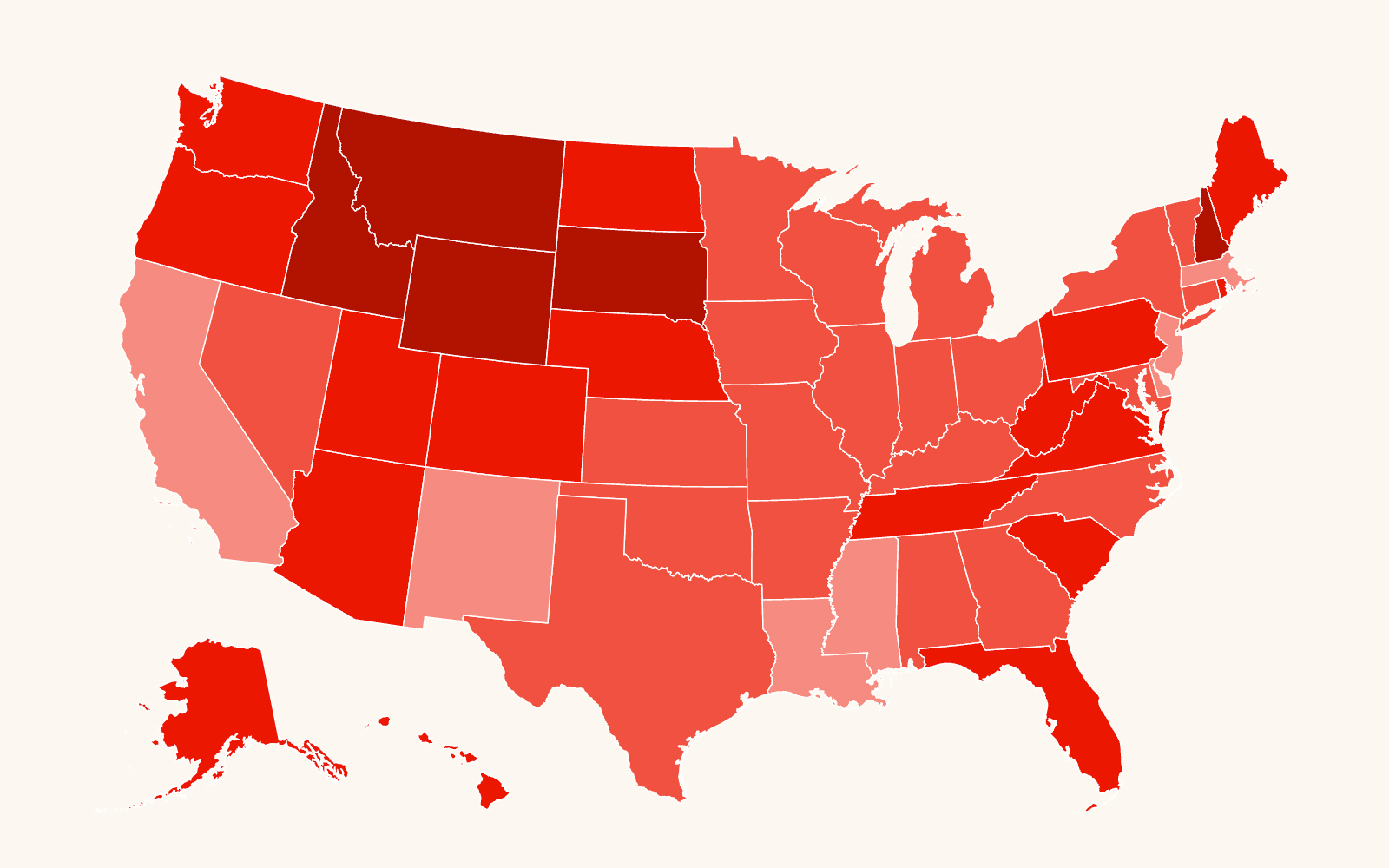Anti-immigrant hate groups are the most extreme of the hundreds of nativist and vigilante groups that have proliferated since the late 1990s, when anti-immigrant xenophobia began to rise to levels not seen in the U.S. since the 1920s.
Top Takeaways
In 2024, the number of anti-immigrant groups dropped to 17, a five-percent decrease from the previous year. Despite this change, 2024 was an especially successful year for anti-immigrant and xenophobic extremists because their rhetoric was heavily parroted by state and federal politicians who also provided opportunities for the groups and leaders of the anti-immigrant movement to incorporate their ideologies into the public-policy process. In addition, anti-immigrant groups benefited from the ongoing politicization of immigration reform and the stalemate produced when Senate Republicans blocked a bipartisan reform measure at the beginning of 2024. The situation allowed anti-immigrant rhetoric to form the basis for much of the 2024 presidential election campaign. Finally, anti-immigrant rhetoric cross pollinated with and was cross promoted by numerous general hate, anti-Muslim, white nationalist and anti-LGBTQ+ groups with detrimental effects for immigrants, civil society groups and local governments in communities from Alabama to Ohio.
Key Moments
Several major developments at the outset of 2024 indicated that anti-immigrant rhetoric would be fevered throughout the year. At the end of January, Senate Republicans refused to back a bipartisan immigration reform proposal after presidential candidate Donald Trump called the bill a “catastrophe waiting to happen,” encouraged senators to oppose it, and said “blame it on me” if the bill failed. The SPLC previously reported that Trump was already using anti-immigrant rhetoric in his presidential campaign. And while immigration activists took issues with some components of the bill, it also proved to be not regressive enough for anti-immigrant groups, underscoring their hard-line approach to reforms.
The first week of February 2024, the “Take Back Our Border” vehicle convoy of protesters departed Virginia Beach, Virginia, for an area near Eagle Pass, Texas, where the state National Guard had “taken control of a public park and refused access to [Customs and] Border Patrol [CBP] agents,” according to news reports. The convoy began after the Supreme Court ruled in late January that the Biden administration could cut razor-wire fencing installed along the Rio Grande River by order of Texas Gov. Gregg Abbot, not long after three immigrants – a woman and her two children – drowned near the area.
The convoy especially underscored how immigration remained a throughline connecting various ideological factions of the hard right and animating their political mobilizations in 2024. The convoy was promoted by SPLC-designated hate groups including VDARE and ALIPAC. Greg Abbott’s efforts were praised by such politicians as Donald Trump and House Speaker Mike Johnson as well as SPLC-designated hate groups Center for Immigration Studies (CIS) and Proud Boys. In a press release, CIS staffer Andrew Arthur said, “There are a lot of news cameras on the border; every time CBP rips out that wire, it will be seen by the public, and show voters how little interest the Biden administration has in enforcing the law.” show voters how little interest the Biden administration has in enforcing the law.”
In the second week of February 2024, the U.S. House impeached Department of Homeland Security (DHS) Secretary Alejandro Mayorkas. The impeachment, mostly along party lines, was peppered with xenophobic rhetoric from lawmakers who claimed Mayorkas to be complicit in the so-called “invasion” of the southern border.
The impeachment effort was lauded by anti-immigrant groups, including the Federation for Immigration Reform (FAIR) who, for months previously, laid the groundwork and spurred on House members to carry out the impeachment as part of their xenophobic agenda. FAIR called on the Senate “to carry out its constitutional duty to hold a full trial and remove Secretary Mayorkas for violating his oath of office and ushering in an historic crisis at our borders.” The Senate chose to not act on the articles of impeachment, but removing Mayorkas was never the primary target; the effort was instead an attempt to create a media spectacle to inject anti-immigrant talking points into the public rhetoric.
On Feb. 22, 2024, University of Georgia student Laken Riley was murdered by an undocumented immigrant man. The killing, combined with the heated rhetoric around Mayorkas’ impeachment, the border convoy, and the failed immigration bill sparked a new flurry of anti-immigrant rhetoric and a harsh anti-sanctuary city law in the Georgia legislature. Anti-immigrant and right-wing groups, as well as their political allies, used these events to further push their nativist agenda and rhetoric.
The SPLC Action Fund collected data about that rhetoric in political campaigns in spring 2024. According to that data, the most common anti-immigrant tropes employed by campaigns at all levels of government were claims of a migrant “invasion” happening and the U.S.-Mexico border being “invaded” and “flooded” with asylum seekers. According to the report, “Migrant ‘invasion’ and ‘invader’ rhetoric feeds into larger ‘great replacement’-style conspiracy theories that suggest mostly nonwhite immigrants are flooding the U.S. and pose a cultural threat to the dominant culture and white demographic.”
The heated rhetoric and hard-right political mobilizations came to a frightening head in September 2024 when vice presidential candidate JD Vance and presidential candidate Donald Trump perpetuated false and harmful conspiracy theories about the U.S. Haitian community in Springfield, Ohio. A neo-Nazi group claimed credit for originating the theories.
Anti-immigrant as well as neo-Nazi and white nationalist groups have long peddled anti-Haitian rhetoric and worked to erode government policies such as Temporary Protected Status, which some Haitians and other immigrant communities benefit from. Some extremist groups like Blood Tribe and the Proud Boys descended on Springfield to agitate the situation.
Established anti-immigrant groups weighed in with rhetoric. ALIPAC wrote in a Sept. 9, 2024, email, “From the cannibalism videos that emerged on Twitter/X from Haiti earlier this year, Americans should be aware that the Haitians will eat you, too, under certain circumstances.” Immigration Reform Law Institute filed a records request for details of animal abuse in Springfield and said in a press release on Sept. 13: “This is what happens when the reckless mass migration policies of the Biden Administration are implemented. The national media has been quick to dismiss charges of animal abuse by migrants in Springfield, but the preponderance of accounts by local residents is too great to ignore. Since the media has abandoned its watchdog responsibility over government, we will pursue the facts here that the people of Springfield and the American public at large deserve to know.”
By the middle of September, dozens of bomb threats and instances of harassment and doxing occurred in Springfield, shutting down many of the city’s public and civic spaces.
Donald Trump’s election victory energized anti-immigrant groups, especially around proposed policies for mass deportations and repealing birthright citizenship enshrined in the 14th Amendment of the Constitution. On Nov. 6, 2024, Mark Krikorian of CIS tweeted, “Message to illegal aliens (incl. ‘asylum-seekers’, parole, TPS, DED, etc, etc): Use the next couple of months to get your affairs in order, pack up your belongings, and go home for Christmas on your own terms. It’ll be easier for everyone, & more dignified than the alternative.” The Immigration Reform Law Institute, a group Tom Homan was working with as senior fellow during the Biden years, congratulated Homan on being tapped for border czar, seeing an opportunity for its anti-immigrant agenda to be actualized.
On Oct. 24, FAIR tapped extremist Sheriff Mark Lamb of Pinal County, Arizona, as a law enforcement adviser, saying he will “spearhead FAIR’s law enforcement outreach efforts, engaging officers and agencies across the nation on immigration issues.” The collaboration fits into FAIR’s longtime strategy to court and work with sympathetic sheriffs and law-enforcement officials. One of the goals is getting sheriffs and local law enforcement to act as extension of DHS’s deportation machine, playing into FAIR’s longtime strategy of halting immigration and removing immigrants to stave off demographic shifts in the nation, which dilute white supremacist power dynamics.
What’s Ahead
Anti-immigrant groups are looking to the second Trump administration to carry out their nativist agenda. A day after the election, FAIR released a wish list of draconian anti-immigrant policies for Trump to enact in January 2025.
Trump campaigned on promises of mass deportations and tapped Tom Homan, the architect behind family separation policies, as border czar to carry out such a task. Homan spent the Biden years associating with hate groups, including working as a fellow for the Immigration Reform Law Institute. Stephen Miller, whose affinity for white nationalism and ties to extremist groups was reported by the SPLC, is also slated to return as deputy chief of staff in the incoming administration.
Trump also floated the idea of repealing birthright citizenship guaranteed under the 14th Amendment of the Constitution, which has been a goal of anti-immigrant movement for decades.
During the last Trump administration, anti-immigrant hate groups were often consulted to weigh in on policy. Members of such groups also rose to serve in immigration-related positions within the federal government.
Background
The organized anti-immigrant movement in the U.S. has long supported draconian immigration-enforcement measures and has worked to stall legislative relief for immigrants and their families and spread bigoted messages.
This movement’s chief architect was John Tanton, a Michigan-based ophthalmologist, white nationalist and eugenics advocate whose tenacity set in motion a network of groups devoted to pushing nativist policies and ideas. Memos donated by Tanton to the Bentley Historical Library at the University of Michigan evidence that his anti-immigrant sentiment was steeped in racism, eugenics and fears of the United States losing its white hegemony.
Although Tanton died in 2019, his legacy lives on through a constellation of groups devoted to his vision. Many of these groups bill themselves as fact-based think tanks engaged in policy research and lobbying; however, their main goal is to spread propaganda targeting immigrants. While not every group designated by the SPLC as an anti-immigrant hate group is part of the Tanton network, they generally push the same nativist and dehumanizing rhetoric. This includes slandering immigrants as inherently criminal, as invaders and/or as threats to the dominant culture.
The flagship group founded by Tanton in 1979 is the Federation for American Immigration Reform (FAIR). Dan Stein, a close confidant of Tanton, remains FAIR’s president, stewarding its same anti-immigrant agenda into the future. In 1985, Tanton founded the Center for Immigration Studies (CIS), which has become a go-to think tank for anti-immigrant groups and nativist-leaning politicians. CIS has a decades-long history of circulating racist writers, while also associating with white nationalists. Tanton also helped found or fund 13 nativist organizations; however, not all are designated as hate groups.
One of the main drivers among anti-immigrant hate groups is vastly limiting or altogether halting immigration to the United States. FAIR claimed in a 2016 video that “mass immigration is too dangerous for America.”
Anti-immigrant groups like FAIR and others are active in Congress, lobbying for nativist legislation and leveraging their partnerships with sympathetic members of Congress to derail relief for immigrants living in the U.S. One extreme measure FAIR has lobbied for is repealing birthright citizenship guaranteed under the 14th Amendment of the U.S. Constitution. ProEnglish is committed to pushing legislation making English the official language of the United States and demonizing inclusive efforts to translate government documents to different languages. Americans for Legal Immigration PAC seeks to fund nativist candidates running for office in the U.S. The House Immigration Reform Caucus, founded in 1999, has been the Congressional arm working to encode much of FAIR’s agenda. And many of the key leaders in the anti-immigrant movement have worked both for outside groups and inside government.
Cordia Strom was FAIR’s legal director, represented the Immigration Reform Law Institute and worked for the U.S. House Subcommittee on Immigration and Claims. In 1996, while working for the subcommittee, Strom helped bring about the Illegal Immigration Reform and Immigrant Responsibility Act, creating the basis for the current mass deportation and detention system.
Anti-immigrant hate groups supported the construction of a wall along the U.S. southern border. Dangerous rhetoric depicting migrants arriving at the border as an “invasion” has been deployed by anti-immigrant groups and hard-line members of Congress. This rhetoric was supercharged in 2022, though nativist figures have pushed it for decades.
In 1994, Tanton and Wayne Lutton, editor of The Social Contract Press, co-wrote the book The Immigration Invasion. One of the central themes of the book is, “Uncontrolled immigration is altering the distribution of political power in the United States.”
Both anti-immigrant leaders were deeply connected to the larger far right. Lutton was also on the editorial advisory board of a publication of the white nationalist group Council of Conservative Citizens (CCC) and The Social Contract Press was responsible for bringing Jean Raspail’s racist novel The Camp of the Saints back into the political fray after two decades out of print. Tanton wrote in a 1999 memo that he hoped the “reissuance of this book will measurably advance the [immigration] debate.”
Anti-immigrant groups are also focused on pushing for draconian measures at the state and local levels. This includes supporting policies making it so hard for immigrants and their families to live and work in the U.S. that they leave, a strategy popularized by CIS called “attrition through enforcement.” This includes supporting problematic E-Verify programs and calling to end so-called “sanctuary city” policies.
Barbara Coe, founder and leader of the California Coalition for Immigration Reform and a self-described member of the Council of Conservative Citizens, organized in 1994 one of the first modern anti-immigrant state initiative campaigns, Proposition 187, which became a model strategy for the anti-immigrant movement.
By 2010, anti-immigrant politicians including Kris Kobach, who served as chairman of the Kansas Republican Party before being elected Kansas secretary of state, had ushered in a series of laws in states and localities, all aimed at restricting immigrant people’s rights and punishing immigrant communities. Arizona’s anti-immigrant SB 1070 law in 2010 brought about a series of copycat policies pushed by anti-immigrant groups around the country, notably in Southern states, including Alabama and Georgia.
Groups like FAIR have encouraged counties to enter 287(g) programs, which deputize local law enforcement to serve as federal immigration enforcement officers. This fits into a larger strategy employed by FAIR and others to court law enforcement officers, including sheriffs, to carry out their anti-immigrant agenda.
Nativist hate can also exist outside the policy realm. The once-listed hate group AZ Patriots, like other border vigilante militias, had harassed migrants at the border as well as representatives from institutions seeking to help them. The many spinoffs and remnants of the anti-immigrant militia group the Minutemen Project, started by Chris Simcox and Jim Gilchrist, remain today in the form of conspiratorial anti-government groups focused on the southern border. All of this adds to a broader climate of sowing fear and bigotry toward immigrants in America.
2024 Anti-Immigrant Hate Groups

American Immigration Control Foundation/Americans for Immigration Control
Monterey, Virginia
Americans for Legal Immigration (ALIPAC)
Raleigh, North Carolina
Border Network News
El Paso, Texas
Border Hawk News
Petoskey, Michigan
Californians for Population Stabilization
Ventura, California
Center for Immigration Studies
Washington, D.C.
Colorado Alliance for Immigration Reform
Lakewood, Colorado
The Dustin Inman Society
Marietta, Georgia
Federation for American Immigration Reform
Washington, D.C.
Floridians for Immigration Enforcement
Pompano, Florida
Help Save Maryland
Rockville, Maryland
Immigration Reform Law Institute
Washington, D.C.
North Carolinians for Immigration Reform and Enforcement
Wade, North Carolina
Oregonians for Immigration Reform
Salem, Oregon
ProEnglish
Washington, D.C.
The Remembrance Project
Houston, Texas
Respect Washington
Burien, Washington


